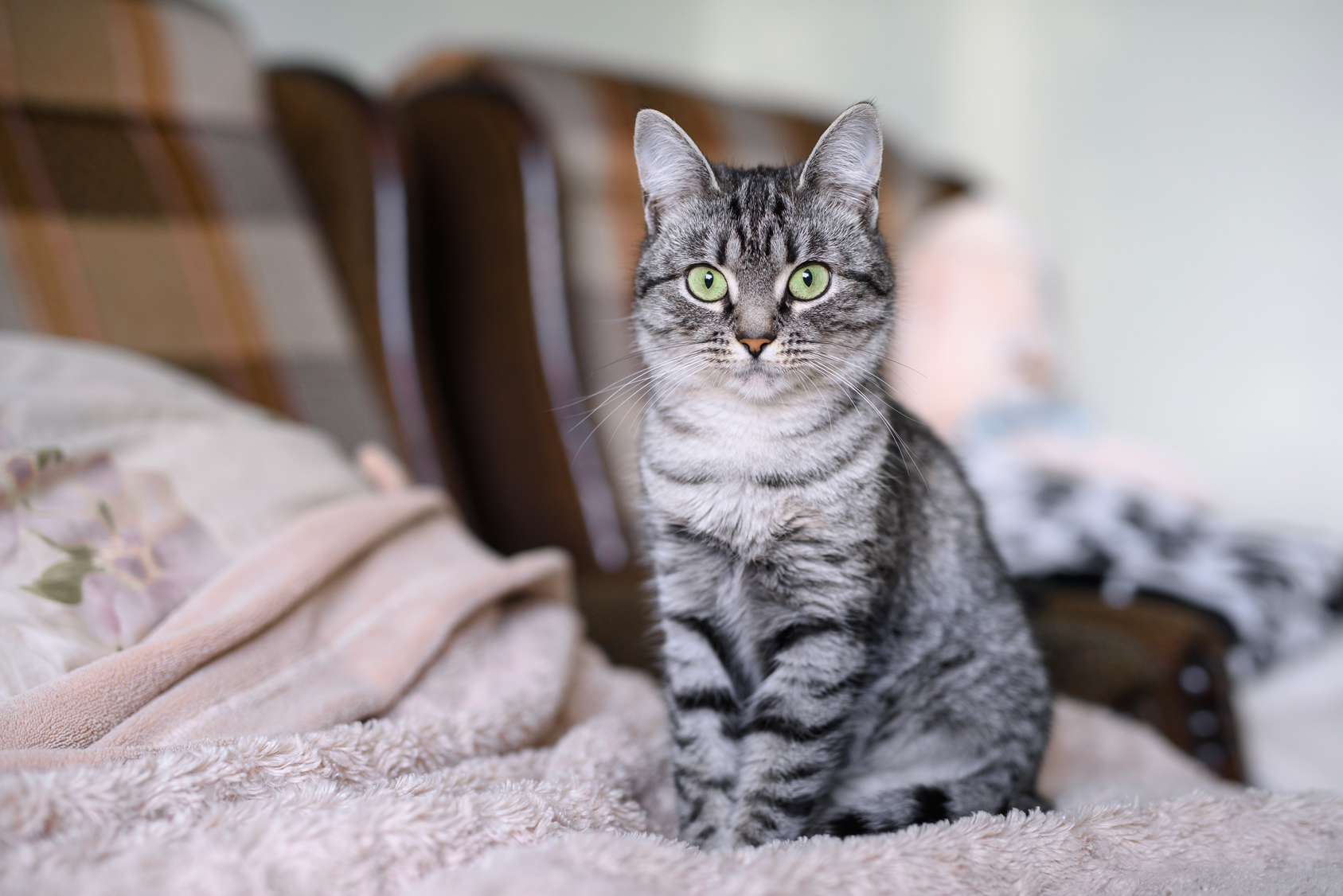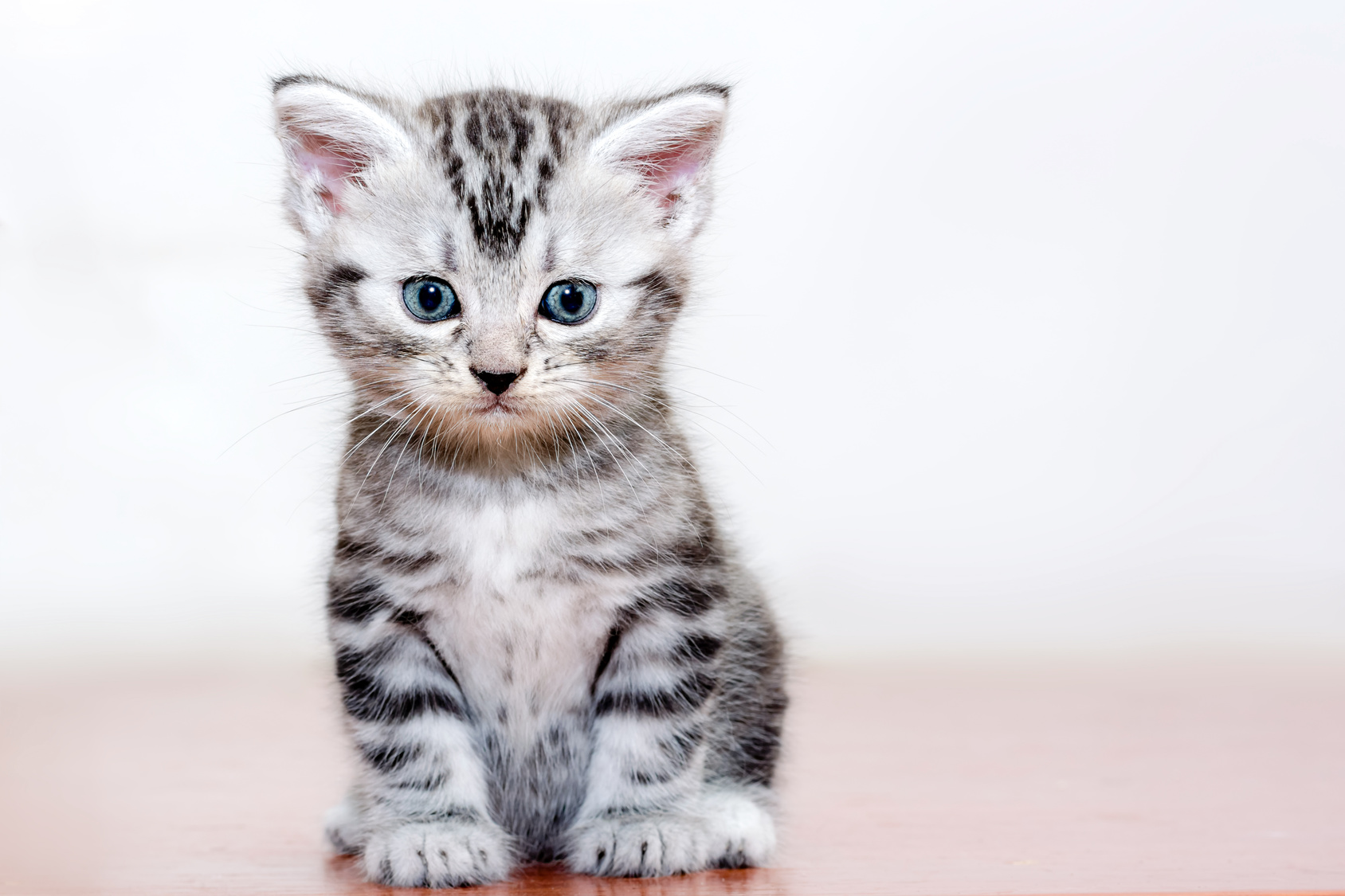Maine Coon
The Maine Coon has become one of the most popular cat breeds in the world. This is probably due to its majestic appearance, robust nature and great character.
Also aboard the ships of the first European settlers in America were four-legged passengers. The cats who travelled with them were prized because of their hunting ability. During long voyages, they kept the mice and rats at bay. They were popular on land too, since they made sure there were no pesky nibblers in the grain storages. It has emerged that these cats are the ancestors of the well known and loved breed that goes by the name of “American Shorthair”.

© fedcophotography / stock.adobe.com
Just like the first settlers, the American Shorthair is an uncomplicated breed. Even though the American Shorthair is predominantly a family cat these days, it has kept its sharp hunting instincts. It is an active and good-natured cat. Just like the European and British Shorthair breeds, these cats display a very even temper, which makes them the ideal fit for families with children. Although this breed of cats does not need as much attention as some oriental cats, they really enjoy spending time with people – whether it be playing with an interactive toy or a gentle cuddle on the sofa.
 © fedcophotography / stock.adobe.com
© fedcophotography / stock.adobe.com
The American Shorthair is a healthy, active, and athletic cat. The medium-sized cat is strong and muscular, but keeps a lean frame – its broad ribcage sits on medium-length legs that are carried by round paws. The tail, also of medium length, has a broad base. The American Shorthair stands out due to its bright golden, attentive, and lightly angled eyes. They sit over a big and sharp snout that fits its concave profile perfectly. Like most things about this cat, the ears are medium-sized, not too far apart, and sit upright.
The fur of the American Shorthair is short, with a similar length and texture to that of the European Shorthair. Which colours are bred depends on the organisation, but most will accept all different fur colours. The Cat Fanciers Association, a famous North American breeding organisation, allows the following colours:
 © tramp51 / stock.adobe.com
© tramp51 / stock.adobe.com
Just like its looks, the character of the American Shorthair is uncomplicated. The breed has kept its ancestors’ traits, which makes them great companions. They have very sharp hunting instincts, but are not aggressive, and have a calm mannerism that works well with families. American Shorthairs love playtime, but are just as happy to curl up and cuddle on the sofa. Their uncomplicated and unassertive presence is a perfect fit for a family home. They are so tolerant that they make great companions for houses with multiple pets. American Shorthairs are very adaptable, so they take well to being in a household, but are just as happy to roam free.
Even though American Shorthairs are often said to have American origins, they travelled there aboard the ships of European settlers. They were known for their dexterity and hard work, and were well loved for their hunting ability that kept the pesky mice and rats away. Rumour has it that the Mayflower, the first ship to sail from Plymouth to America, carried American Shorthairs on-board. No wonder the breed is so humble and grounded! Systematic breeding did not occur until the start of the 20th century.
At the beginning of the 19th century, the bloodline of the American Shorthair was close to thinning out, so a group of breeders started a specialised program. The original name, “Domestic Shorthair”, was dropped in favour of “American Shorthair” in the process. This was done to underline its American heritage and set it apart from other domestic cats. Despite this, the breed was still a bit looked down at events and shows until the 1960s, probably due to its similarity to the “normal” house cat and their sweet and uncomplicated disposition.
The American Shorthair, just like any other breed, has tightly defined breeding standards: build, hair length and colour, and the warm and uncomplicated character all have to be of the right sort. Most breeders warmly accept all colours, but the “Silver Tabby” has still proven itself especially popular. Just like its British Shorthair cousin, the “Silver Tabby” its popularity stems from an almost identical likeness to the cat in the famous Whiskas ad!
American Shorthairs have become a staple in the North American breeding scene! European admirers of this breed normally have to dedicate more time to finding their perfect pet. As with all cat breeds: only a professional breeder is a good breeder. The care and dedication that the breeder puts into the offspring is a vital factor in the development and physical and mental health of the kittens. A responsible breeder makes sure that the mother cat gets ample rest after each litter. This reduces the number of litters and profit, but this is more than compensated for by the wellbeing of the mother cats. The couples are chosen carefully to avoid any genetic illnesses and ensure compatibility, and a medical eye is kept on the kittens during the whole pregnancy. After the birth of the litter, there is another examination by the vet and the kittens will receive everything they need to flourish: good kitten food, all the necessary injections, and social contact with its siblings, other cats, and the members of the guardian family. The cat should stay with the breeder until it is 12 weeks old, since it takes 3 months for the mother cat to pass down all its knowledge to its young and ensure that they are ready to take on the world out there as well-balanced and healthy kittens. This is where the charming and uncomplicated disposition of the American Shorthair is passed on!
The breeder that earns your trust should be a member of a breeding society. This is the only way to get certified papers that prove that your cat is an “American Shorthair”. When you are thinking about getting a new pet, the last thing you want to think about is a piece of paper, but it acts as proof that of proper breeding conditions, heritage, and gives you the confidence that your cat really is an American Shorthair.
This is by no means a cheap process, so breeding is normally an expensive passion rather than a paying job. Cats that come from a professional breeder are more expensive than cats at a low price without papers for this reason. The cheaper alternatives come at a sharp trade-off: inbreeding, insufficient care and attention, and lacking health provisions mean that your cat will not be as healthy and uncomplicated as you wish… Simply put, only place your trust in professional breeders. Alternatively, there are many cats in homes who would be overjoyed to move in with you!
As a shorthair breed, the American Shorthair doesn’t need much special attention, but especially when it sheds, it’s worth giving it a brush once a week. Other than that, the cat takes care of itself and rarely needs help. Cat grass and malt paste can aid the passage of swallowed hair.
Furthermore, the American Shorthair is known for its longevity and robustness. As a rule of thumb, a yearly check-up at the vet should keep your cat in tip top shape.
A lot of American Shorthair lovers have noticed that the breed has a tendency towards hypertrophic cardiomyopathy (HCM), which is a growth in the cardiac muscle. Your vet will listen to your cat’s heartbeat during the regular check-ups, to give prior warning or to settle any worries. HCM is a hereditary disease, so it is very important to not breed cats that display it. While the disease has no cure, your vet can advise on a combination of medication and the right diet to let it live its days in relative comfort!
 © topphotoengineer / stock.adobe.com
© topphotoengineer / stock.adobe.com
American Shorthairs tend towards a relaxed lifestyle, and can pile on a few extra pounds, especially after castration. The best antidote is a healthy, balanced diet that includes lots of animal protein but keeps carbohydrates low. This ensures they get everything they need to be healthy without anything that might take an extra toll on its organs or lead to weight gain. There are a variety of high-quality foods that meet your cat’s dietary requirements perfectly. Meat should be first on the list of ingredients, and plant-based products should be as low as possible. Ideally, sugar does not make an appearance.
Raw diets and home-made food are a great option, but can be a little time-consuming. This way, you know exactly what’s going into your food. With a little bit of research, you will know exactly what your cat needs.
A fun way to prevent unwanted weight gain is regular playtime: dangler games and chase games can tease your cat into action. If you have room for a large cat tree, this gives your cat plenty of room for exercise. You can also stimulate your cat’s curiosity with interactive games.
If your head has been turned by the American Shorthair, there is only one place to go: to a professional breeder. We wish you and your American Shorthair nothing but the very best!
| Origin | Developed from cats brought to North America by European colonists |
| Size | Medium |
| Weight | 4.5 – 7 kg (10 – 15 lbs) |
| Lifespan | 15 years (sometimes up to 20) |
| Price | From 600 euro, up to 1,500 euro |
| Temperament | Sociable, People-oriented, Easygoing |
| Coat Colors (Cat Fanciers Association) | White, Black, Blue, Cream, Red, Bi-color, Chinchilla, Smoke, Tabby, Calico |
| Coat Colors (Other Associations) | All Colors Accepted |
| Care | Easy |
Here are some purchase proposals curated by the zooplus editorial team
The products featured have been carefully selected by our editorial staff and are available at the zooplus online pet shop. The selection does not constitute advertising for the mentioned brands.
The Maine Coon has become one of the most popular cat breeds in the world. This is probably due to its majestic appearance, robust nature and great character.
Large eyes and attentively upright ears instantly tell you a great deal about this charming breed of cat: Abyssinians are inquisitive and affectionate towards people.
With its long, dense fur, rounded ears, and intense stare, the Pallas Cat, or Manul, looks rather fluffy, yet somewhat dangerous. However, don't be fooled by its appearance—this is no petting zoo resident. The Manul is a wild animal and considered untameable.